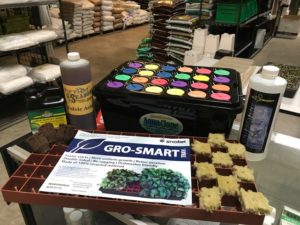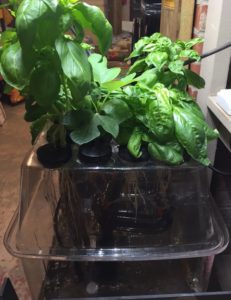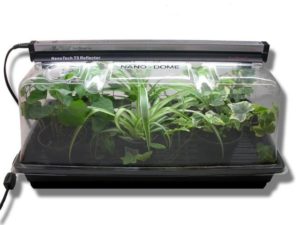-Mike Weeks-
One of the most common frustration we find with our customers is on the subject of cloning. Growers that have been taking clones for years will occasionally fall into a bad habit, and not know why their success rates have plummeted. This blog post will point out some of the most common mistakes made in the cloning room and how to avoid them for future cloning success.
Healthy Plant Stock
The first step in getting healthy clones is to start with a healthy stock plant (the plant you will cut from). Your plant should have strong genes, should be free of pests or diseases, and should not be displaying any symptoms of deficiencies or stress. This plant should also be large enough to support cutting from. If the plant is a fresh seedling, give it time to develop so that there’s healthy side branches to cut from. Generally speaking, the best time to take a cutting is when the plants are actively growing. Sometimes we are forced to take a cutting while a plant is flowering, and this can work, but be prepared for it to take a little longer.
***Grower tip – Spray your stock plants with seaweed and fulvic acid a few days before taking cuttings. This will prime the plant to hold on to nutrients longer, giving the cutting a better chance to survive in the fragile rooting environment.
Ensure Proper Moisture
Many growers make the common mistake of keeping their media too wet. Moisture and humidity are key in cloning, but wet is not good. Wet media lowers the oxygen levels in the media, which usually leads to rotting stems. Two of the most common medias used in cloning are rockwool and starter plugs. Rockwool is preferred for hydroponics, but could be used in soil. Starter plugs can be used in both. I personally lean towards starter plugs because of their ability to hold moisture, yet breathe. Rockwool is dry when purchased and will need to be soaked in a slightly acidic water solution (5.5 pH is ideal). After soaking, some of the water will need to be gently squeezed out of the media. This will pull more air into the media, giving a better water/air ratio. The same can be done with the starter plugs, but these will come pre-moistened almost to the proper levels. I give my plugs 2 or 3 squirts of water directly to the top before I place my cuttings. The media should be evenly moist, but not dripping with water. Remember, oxygen is key! The media should never be sitting in water (commonly asked question). Grodan makes an insert call the Gro-Smart Tray that elevates the rockwool off of the bottom of your flat tray, allowing you to fill the bottom of the tray with water, without the rockwool sitting in it.

Keep it clean!
Be sure to start with clean equipment. Some growers prefer to buy new domes and trays every time they clone, but these products can be cleaned and sterilized by using a 15% bleach solution or food grade hydrogen peroxide. For easy-to-wipe surfaces, use 3% hydrogen peroxide. A stronger concentration will be needed for water cloners that contain hard to reach surfaces inside pumps and manifolds (34%). These practices are especially important if you are using hydroponic cloners like the EZ-Clone or Super Sprouter AquaClone. Infection of bacteria is probably the number one cause of failure in these systems.

Temperature
The last paragraph segues perfectly into this one because higher temps bring on more bacteria. It is critical to have full control over your grow room temperatures if you want to remain successful with cuttings year round. Problems often occur in the summer when grow room temps are 80 degrees or above. The ideal temperature for a space is around 75 degrees, and humidity should be in the 60 to 80% level. We highly encourage heat mats during the winter, but be careful not to bake your clones. Give some space between the heat mat and the tray by elevating it an inch or so. I use another flat tray upside down to give the right spacing. Heat mat thermostats are also available to help regulate temperature.
Proper Light
Over-lighting a fresh cutting can easily cause it to droop and stress. We are trying to minimize water transpiration from the leaves once the cutting has been made, so soft light is preferred for this process. One T5 over a single flat tray is adequate lighting. The Super Sprouter Combo is a great example of an ideal set-up. If using a larger T5 unit (4 to 8 bulb), put the light higher than you would with single T5 fixtures (roughly 36”above the plants). This will ensure that you don’t overlight the fresh clones, and will also increase your cloning square footage.

Fresh Rooting Gel (or Liquid)
Your rooting solution should be fresh for best results. A gel that has separated and doesn’t look consistent has more than likely gone bad and should be discarded. An old gel or liquid can actually do more harm than good. It is also good practice to pour off what you think you may use into a separate container like a shot glass or floral stem, and use that to dip your cuttings into. Contamination into your stock bottle with shorten its shelf life.
Let them ROOT!
Lastly, I know that folks get impatient and want to check on their clones to see if they’ve produced roots, but give them space for at least five days. I tell customers to not even open the lid for that long if they can see that the clones look healthy inside the dome. Disturbing the media to check for roots can just delay the process. Patience is key when it comes to success.
I hope these simple tips will be helpful to you. Feel free to comment if you have any specific questions, and we will be sure to get back with you.

Jackson Carreras says
hey I’ve been growing for years, but my clones have all been dying in the past 2 weeks. they look great for about 3 to 5 days and then they Wilt and rot. I’m going to switch back to clone X, clean everything, spray my plants and make sure they have no pests, I have fulvic acid… but how are 3 sprays of water going to keep them wet and humid enough for 5 days?
ashley says
Hi Jackson,
Ok, there are a few golden rules for cloning. I’ll list the top 3 mistakes first and offer some guidelines.
1. Over Watering – your media should be moist, but not dripping wet, and certainly not sitting in water. Soak your media and squeeze out part of the water. If it is dripping, it is too wet.
2. Too much or too little heat – the temp in your space should be 75-78. If you need a heat mat, use something to create a little space between your cutting and the heat mat, such as a flat tray flipped upside down. That would give a couple inches to prevent burning them up.
3. Too much light – you probably are not guilty of this if your clones are lasting that long without wilting. If they drop within a few hours, that is the case.
Cleanliness is key, as well as using a fresh bottle of cloning solution. Clonex works just fine, but many others do as well. Good call on cleaning everything. Sterilize as well.
If you have a good seal on your dome and flat tray, you should not lose much moisture, if any. If you can see condensation on the dome, the moisture level is fine. If you continue to have issues, you may want to check into your stock plants. Are they getting old or stressed?
I hope this helps!
Lo says
I’ve been cloning for years but only recently went from a 90% constant success rate to 10%.
I keep getting dead brown spots in certain leaves too. Like no yellowing.. nice bright green leaves with a few completely dead brown spots that become more numerous over time.
Any ideas?
I also have been using my clone machine under a fluorescent light (2 ft away).. for the first 2 weeks.
Then transplant to soil cup.. and put under 600W viparspectra LED (2 ft away for next week.. then move closer for rest of cycle)
Sandro says
One weird I am growing my fig cutting in a big plastic closed with a lid. The plant are doing great, but when I take the lid off or the plants out, the cutting droop in an hour. If I put them back in the tub and close the lid, they get perky again.
Electric Lettuce says
Thanx 4 the tips. I thot i was doin a few things,not quite rite. Now u have confirmed my unknows & unsures. Gonna take ur advice & i m sure i will have better success.
Andriws says
I need some help, my dome has respiratory air ways all around, should I keep this airways open or closed ?
ashley says
If you are germinating seeds, you can leave the vents closed until they germinate, and then open them to get some air-flow and keep temperatures from getting too hot. If growing cuttings/clones, it’s good to have some vents open for air circulation and temperature control. Hope that helps!
Wolfman says
If you are using a clone machine (aeroponics) you can lose the dome and run a small, cool water humidifier inside a small space like a closet. And use the fulvic/kelp foliar spray on the stock plant.
It is also important to keep the cloning solution out of your water. Take the cuttings, dip in gel and place in the cloner but don’t turn it on for 30 mins. Let the cloner run long enough that the gel is visibly gone and change your water to fresh. The gel can make the water a bit funky and lead to bacterial issues.
Was wondering if you run the cloner continuously or on regular intervals. I have great results running for 15 mins on and 30 off. It seems to stimulate root growth.
Nick says
What if I have been feeding for last 9 days during cloning cycle EC 2.5 now just realized I should of had EC level at 0.5 to max 1.3 what would be the best solution
ashley says
Hi Nick,
If you aren’t seeing any yellowing, I would just drop the EC down to 1.0-1.3 and hope they didn’t get lockout. If there is yellowing, you might have had too much toxicity and plants won’t bounce back. Fingers crossed – Ryan at FSG
Nick says
So far they are looking good all green no yellow up today, start dropping EC to 1.3 already .
Oh , I fed RO water for only one day and start EC at 1.3 so far haven’t seen any yellow they are all green And healthy so far
Aria says
What’s your cyle of opening and closing the vents on your clone trays?
ashley says
Hi Aria,
You wanna keep them closed for 5 days, and then slowly crack them open over the next 7 days. It usually takes between 14-21 days for root development. Hope that helps! — Ryan at FSG
Mike says
Hello, im hopping someone can help.. I have cloning machines that spray water up from the bottom… I just added a second 1 an for some reason I keep getting a goo that covers the bottom of the plant… the top looks ok its almost like the goo seals the bottom but prevents it from rooting any suggestions
ashley says
Hi Mike,
It’s a type of bacteria that develops if the water isn’t changed often. To get rid of it you need to thoroughly clean with dawn dish soap and high strength hydrogen peroxide. To help keep it from re-occurring, use Clear Rez from ez clone weekly.
CalculatedEvils says
Aand yes, clonex solution @ 5 – 8 ml/gal, in conjunction with superthrive 2 – 3 drops/gal
pH’d at 5.9 – 6.1 just completely rocks
I don’t sweat temp beyond comfortable, slightly warm (but really just lack of chill) room temperature, aand I’ve never used a heat mat, or a dome either. If I did, they might be a couple/few days quicker…but I essentially get a 100% across the board without, with maybe the very rare freak occurrence
Cm says
When cloning. When I soak the cubes. Do you put nutrients in that wayer too. I was told don’t do it until they establish roots.
ashley says
Hello, I typically don’t add nutrients if I soak my cubes, but I have heard of people using Clonex solution or Azos when they soak theirs. I personally couldn’t tell the difference when I’ve tried it before. Hope this helps — Ryan an Fifth Season Gardening
painters says
Thanks for the advice. I believed I was acting in a few unwise ways. Now you have validated my doubts and uncertainties. I’m going to follow your suggestions, and I’m confident I’ll succeed more.
Kimberly S Moran says
Does Athena Cuts cloner gel cause my cloner water to suds up? I have cleaned and sanitized everything. It’s the only common factor right now and I’ve gone through the process twice, and the plants started to wither. Just curious if any other clones are seeing this?
Sandy says
I need help with my plants my plants are weltering I have them inside at nighttime take them outside during the day so they look like they’re dying What can I do to fix the problem?
brian says
Hi Sandy. If your plants are new clones (my assumption since this is a post about cloning) it’s probably best for you to start over. Outdoor conditions are a bit too much for them. While cloning can be frustrating, if you follow the steps in this post you’ll greatly increase the likelihood of success. Best of luck!